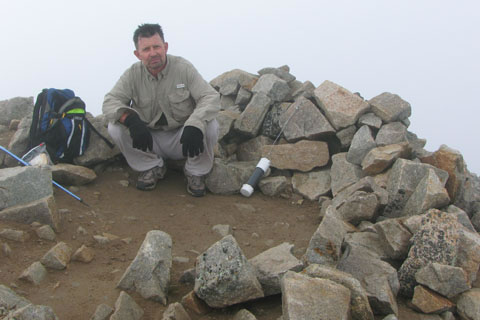| 313 | Hiking Skills - The Ten Essentials - Clothing | 2010-11-29 |

A couple of years ago we climbed Mount Huron on a cold, overcast, drizzly kind of day. As we climbed it grew even colder with frigid weather on the summit. We met a man on the summit who oddly enough was not wearing a coat.
Overhearing a conversation the ill clad adventurer, Huron Man, was having with another summiteer, made it clear what had happened. Huron Man claimed he could only walk at one speed - fast. His group could not keep up with his fast pace, so he left them. Huron Man scampered as quickly as he could to the top. When he arrived at the summit he was caught unprepared (but not complaining) by the frigid temperatures. He was wearing cotton clothing, he had been sweating profusely, and he had no extra clothing in his day pack. Even though he was noticeably shivering when we arrived, he was determined to wait on the rest of his group.
We touched the top and quickly descended to better weather.
We were amazed by Huron Man. He had made several hiking and clothing mistakes. Yet, he sat quietly at the summit waiting for the others in his group while paying his penance for his errors. He made us cold by our just looking at him.
There are a few lessons to learn from Huron Man:
When you dress for the mountains or for any other backcountry hikes, wear clothing that dries quickly and retains it's insulating properties even when it's wet. Cotton is hardly ever an appropriate fabric.
Always regulate your body's temperature. In poor weather temperature maintenance is even a more critical task. Basically, you never want to sweat. By dressing in layers you can remove layers or vent clothing to reduce accumulating heat. If you are still too warm; then you need to slow down and take more breaks. If you get cold, you can hike faster or add layers.
Carrying extra clothing is one of the ten essentials. Always wear clothing suitable for the weather and carry an extra layer.
A few extra clothing tips ...
- A hat and gloves are lightweight and add a tremendous amount of warmth for the weight.
- Regulating your body temperature is important. Do not let yourself get hot or cold.
- Keep your extra clothing easily accessible.
- Add an extra layer of clothing when you stop for breaks.
- Don't forget rain gear. They would not be considered as an extra layer except in warm conditions.
- When hiking in a group, check with each hiker to see what they are carrying. Some gear might be able to be shared, even clothing.
- We often use waterproof (non-breathable) rain gear as a part of our emergency gear. These jackets are used for hunkering down, not moving. They add a lot of warmth for the weight.
- I sweat a lot and if I am planning on moving fast - regardless of sweating - I carry an extra base layer to replace my wet one.
- Always bring an extra insulating layer.
- Make sure you check the weather forecasts and dress appropriately.
- If you are ill prepared for the weather, turn around.
We use (other garments are also okay!) ...
Patagonia Capilene Base Layers (wool is also very good)
Patagonia and Marmot rain gear
Patagonia Puff series or down from Feathered Friends, Western Mountaineer, Mountain Hardwear, Sierra Designs, and North Face.
Most of the clothing mentioned is available from our affiliates' sites in the right sidebar.
Happy warm extra clothing trails.
Links to Essentials
